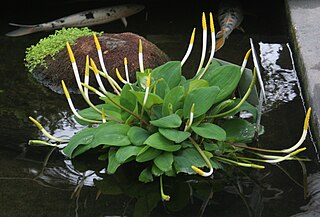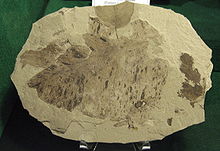
Orontium aquaticum, sometimes called golden-club, floating arum, never-wets or tawkin, is a species of flowering plants in the family Araceae. It is the single living species in the genus Orontium, which also contains several extinct species described from fossils. O. aquaticum is endemic to the eastern United States and is found growing in ponds, streams, and shallow lakes. It prefers an acidic environment. The leaves are pointed and oval with a water repellent surface. The inflorescence is most notable for having an extremely small almost indistinguishable sheath surrounding the spadix. Very early in the flowering this green sheath withers away leaving only the spadix.

Tilia johnsoni is an extinct species of flowering plant in the family Malvaceae that, as a member of the genus Tilia, is related to modern lindens. The species is known from fossil leaves found in the early Eocene deposits of northern Washington state, United States and a similar aged formation in British Columbia, Canada.
Peltandra primaeva is an extinct species of monocot in the family Araceae known from a Ypresian age Eocene fossil found in western North Dakota, USA.
Neviusia dunthornei is an extinct species of flowering plants in the family Rosaceae. The species is solely known from the early Eocene, Ypresian stage, Allenby Formation Lacustrine deposits near the town of Princeton, British Columbia.
Acer douglasense is an extinct maple species in the family Sapindaceae described from fossil leaves. The species is solely known from the Early Eocene sediments exposed in Katmai National Park and Preserve, Kodiak Island Borough, Alaska. It is the type species for the extinct section Douglasa.
Acer stonebergae is an extinct maple species in the family Sapindaceae described from two fossil samaras. The species is solely known from the Early Eocene sediments exposed in northeast Washington state, United States, and the adjacent area of south central British Columbia, Canada. It is one of three species belonging to the extinct section Torada.
Acer toradense is an extinct maple species in the family Sapindaceae described from two fossil samaras. The species is solely known from the Early Eocene sediments exposed in northeast Washington state, United States, and the adjacent area of south central British Columbia, Canada. It is one of three species belonging to the extinct section Torada.
Acer hillsi is an extinct maple species in the family Sapindaceae described from a single fossil samara. The species is solely known from the Early Eocene sediments exposed in northeast Washington state, United States and the adjacent area of south central British Columbia, Canada. It is one of only two species belonging to the extinct section Stewarta.
Acer stewarti is an extinct maple species in the family Sapindaceae described from a series of fossil leaves and samaras. The species is solely known from the Early Eocene sediments exposed in south central British Columbia, Canada adjacent to northeast Washington state, United States. It is one of only two species belonging to the extinct section Stewarta.
Acer republicense is an extinct maple species in the family Sapindaceae described from a single fossil samara. The species is solely known from the Early Eocene sediments exposed in northeast Washington state, United States. It is the only species belonging to the extinct section Republica.

Fothergilla malloryi is an extinct species of flowering plant in the family Hamamelidaceae known from fossil leaves found in the early Eocene Klondike Mountain Formation deposits of northern Washington state. The F. malloryi leaves are the earliest appearance in the fossil record of a member of the witchalder genus Fothergilla, which includes the living species F. gardenii, and F. major, both of which are native to the southeastern United States. The genus also includes three or four other fossil species with two Asian Miocene species, F. viburnifolia from China, F. ryozenensis from Japan along with one Miocene North American species, F. praeolata of Oregon. Fothergilla durhamensis described from Eocene sediments in King County, Washington is considered dubious in placement.
Corylopsis reedae is an extinct species of flowering plant in the family Hamamelidaceae known from fossil leaves found in the early Eocene Klondike Mountain Formation deposits of northern Washington state. C. readae is one of the oldest occurrences of the winter-hazel genus Corylopsis, which includes between seven and thirty species, all found in Asia. Fossils from two other occurrences are of similar age to C. readae, with Paleocene specimens from Greenland being placed in the form taxon Corylopsiphyllum and an Eocene Alaskan fossil being included in Corylopsis without species placement.

Orontium, sometimes called golden-club, is a genus of flowering plants in the family Araceae. The single living species in the genus is Orontium aquaticum, while the two other described species, Orontium mackii and Orontium wolfei, are known from fossils.
Orontium mackii is an extinct golden club species in the family Araceae described from a series of isolated fossil leaves. The species is known from Late Cretaceous sediments exposed in the state of New Mexico in the United States of America. It is one of several extinct species placed in the living golden-club genus Orontium.

The Allenby formation is a sedimentary rock formation deposited during the early to early Middle Eocene. It consists of conglomerates, sandstones with interbedded with shales and coal. The coal seams contain an abundance of insect, fish and plant fossils, known from the shales since 1877 but best known from the Princeton Chert.
Stonebergia is an extinct genus in the rose family, Rosaceae, which contains the single species Stonebergia columbiana. The genus was described from a series of isolated fossil leaves in shale from an early Eocene location in southern British Columbia.

Rhus malloryi is an extinct species of flowering plant in the sumac family Anacardiaceae. The species is known from fossil leaves found in the early Eocene deposits of northern Washington state, United States. The species was first described from a series of isolated fossil leaves in shale. R. malloryi is one of four sumac species to be described from the Klondike Mountain Formation, and forms a hybrid complex with the other three species.

Rhus garwellii is an extinct species of flowering plant in the sumac family Anacardiaceae. The species is known from fossil leaves found in the early Eocene deposits of northern Washington State, United States. The species was first described from fossil leaves found in the Klondike Mountain Formation. R. garwellii likely hybridized with the other Klondike Mountain formation sumac species R. boothillensis, R. malloryi, and R. republicensis.
Rhus republicensis is an extinct species of flowering plant in the sumac family, Anacardiaceae. The species is known from fossil leaves found in the early Eocene deposits of northern Washington state in the United States. The species was first described from fossil leaves found in the Klondike Mountain Formation. R. republicensis likely hybridized with the other Klondike Mountain formation sumac species Rhus boothillensis, Rhus garwellii, and Rhus malloryi.

Tetracentron hopkinsii is an extinct species of flowering plant in the family Trochodendraceae. The species is known from fossil leaves found in the early Eocene deposits of northern Washington state, United States and south Central British Columbia. The species was first described from fossil leaves found in the Allenby Formation. T. hopkinsii are possibly the leaves belonging to the extinct trochodendraceous fruits Pentacentron sternhartae.







